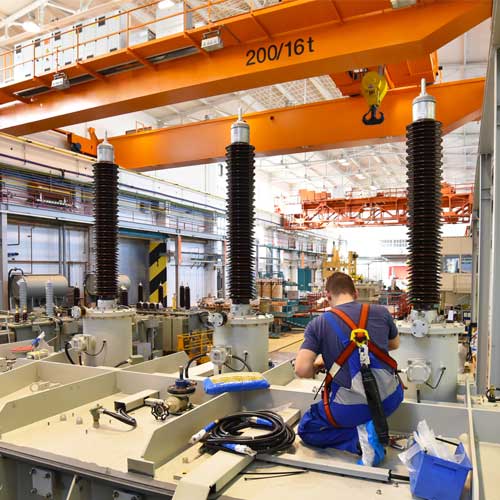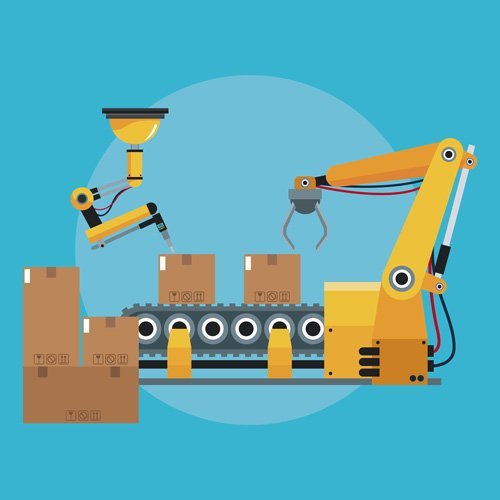
by The HLH Team
This Waste is about saving a few seconds per process, then multiplying that by the thousands of processes you do in a given period. It’s incremental, highly detail-oriented, and adds up quickly.
The Invisible Waste:
We’re used to looking for movement and action, waiting is often invisible because it’s the lack of either; it’s inaction that’s often built into the fabric of our everyday processes. If you’re not explicitly watching for Waiting Waste, your eyes will look right through it.
Much like Motion, the more times you repeat a process, the more valuable it is to tighten it by a minute, or even a few seconds. Start with your most repeated processes first and look specifically for Waiting Wastes (otherwise, you’ll miss them).
Waiting within Process:
 This is rampant on most production floors. No matter the product, every step in the manufacturing process builds cumulatively on the steps before, often incorporating more materials to add value. If the materials aren’t available, the process stops. Then, every step after it stops. The earlier in the process it happens, the more disruptive it tends to be.
This is rampant on most production floors. No matter the product, every step in the manufacturing process builds cumulatively on the steps before, often incorporating more materials to add value. If the materials aren’t available, the process stops. Then, every step after it stops. The earlier in the process it happens, the more disruptive it tends to be.
Often it happens when an earlier process is faster than a subsequent one, causing a backlog. This can be the hardest to spot, especially if you have good people.
Faced with waiting, a strong employee won’t just stand there. He or she will get busy. If you’re walking by, you won’t notice irregularities because everyone is moving and working, but “busy work” isn’t productive, and it’s not sustainable. Change can’t come from your office chair. You need to learn the processes intimately and your staff must trust you enough to feel empowered to speak up when they have nothing to do. Once you know about the in-process Wastes, it’s often easy to shift timings around to fill them.
Waiting for Materials:
Fixing a Deadly Waste is like taking a pill: sometimes there are side effects. If you’re suffering from rampant over-inventory of raw materials, you’re probably never stuck waiting for it. If you trim that Waste and stay close to the rocks, it becomes a game of polishing logistics.
Lean manufacturing has very little raw material at hand. If a shipment is late, backordered, shipwrecked, etc., your entire production could halt. This has become a stumbling block for some Lean companies, including Toyota itself, but is all a part of the learning process and shouldn’t be feared.
Machine Downtime:
 We’ve all been there and it’s infuriating. It reminds us that while we can trim some expenses, maintenance can’t be one of them.
We’ve all been there and it’s infuriating. It reminds us that while we can trim some expenses, maintenance can’t be one of them.
Whether it’s a fleet of trucks or a lathe, invest the money to put your critical equipment on a regular, and arguably generous, maintenance schedule. At first, it may seem like a good idea to cut the mechanic without notice, but when forklifts fail and people are dismantling pallets to carry goods by hand, Waste adds up fast.
Regular maintenance also extends equipment life. Once a vehicle or machine is purchased, it is almost immediately written off, so the longer it lasts, the better.

by The HLH Team
Overproduction is what happens when idealism runs amuck. You have the orders coming in, and see no reason why they shouldn’t keep coming in and increasing, so you charge full-speed ahead.
Our hubris swells watching our finished widgets roll off the line. So much so, that it becomes easy to forget that sometimes they aren’t sold yet, and their production is a leap of faith. A leap that could, should customers not come through, leave you without a parachute.
This is the king of the Deadly Wastes. It’s the most dangerous. It not only ties up your cash flow, but makes you vulnerable to market changes, leaving you blind to other Wastes happening around you. When we’re overproducing, it’s harder to keep a rational distance to see other Wastes eroding your bottom line.
Just-in-Time:
It’s a prevailing myth that it costs more to shut down an assembly line than to just keep producing. This is the deceitful heart of Overproduction. In Lean manufacturing, if you don’t have the orders, you don’t make the widgets. Period.

Just-in-Time (JIT) is a key pillar of Lean and, for businesses serious about cutting costs, a central goal. It’s elegantly simple:
- You carry just enough inventory to cover the bare minimum of expected orders;
- Build flexibility into your supply logistics; and
- When you get the order, you make the widgets. No more, no less.
JIT operates on a “pull” philosophy: the customer’s order pulls the product through the assembly line for delivery. Overproduction is the opposite: we push the product through the assembly line to pile up in hopes that if we build it, the customers will come.
Inventory:
Overproduction doesn’t act alone, it spawns over-inventory. Together, these two Wastes cripple your cash flow, clog your aisles with unsold product, and keep you anxiously wondering how to get rid of it all.
Batch Sizes:
We overproduce for many reasons and it may be the result of another pernicious myth: that larger batch sizes are always better. Here’s how it works:
- You get too much raw material, and you want to practice efficiency by not storing it. So you pump a ton of money into producing it all, regardless of the orders you have.
- Bigger batches automatically mean saving money (keeping your machines running means you won’t waste time starting them up again), so everything goes into production!
- The product will definitely sell: why wouldn’t it?
This is how a desire for efficiency leads to massive Waste. It happens over and over, and the cycle needs to stop if businesses want to take control of their production again.
Shelf Life:
How long can you sell your product at full price? Once it’s stacked up on those back shelves, its value plummets like driving a car off the lot.
When you can predict obsolescence, like milk expiring, then you can build it into your production process and manage it. But technology, customer expectations, competitors’ tactics, and more can change rapidly and unexpectedly.
With a warehouse full of Overproduction, you forfeit your ability to adapt to market conditions. Instead of being proactive to changes, the value of your outdated product becomes a victim and you’ll have no choice but to discount or discard, the paralysis that Overproduction inflicts.

by The HLH Team
Defects are the easiest Waste to spot. The trick to this Waste is spotting them before the product goes out your door, into the public eye. By the time you catch a Defect, the lost production cash is often the least of your worries. Loss to reputation, angry customers, and the cost of repairs all trump wasted productions costs. Often, the insult to injury is paying people to throw it away.
Layers of Expensive:
By the time you notice a Defect on a finished product, you’ve already put maximum resources into the product. Like Over-Inventory, that has the effect of freezing your cash into that product. Unlike Over-Inventory, you usually can’t just discount it to sell. You’ll need to put more money into repairs first.
Proactivity is the best defense. The earlier in the process you see a defect happening, whether through a bad part or sloppy process, the better. It becomes more expensive the farther in the process it goes.
Empowering Staff:
 Even an engaged manager can’t be on the production floor all the time. Defects happen everywhere, but whether they’re caught or missed depends on how many people are actively monitoring.
Even an engaged manager can’t be on the production floor all the time. Defects happen everywhere, but whether they’re caught or missed depends on how many people are actively monitoring.
Your team needs to care about spotting Defects. They need to be engaged in the process improvement process. To be engaged, they need to know that they won’t be blamed or punished for Defects they point out, and they must want to help improve the company.
Talk to them about their ideas. Formal and scheduled are necessary, but also strive to create a rapport where you can chat informally, wherever you are, and they feel heard.
Reputation:
There’s no such thing as a non-competitive industry. If your product doesn’t meet customer expectations, your competition is an email away. It needs to be right.
Company brand and reputation takes a long time to build, but it can fall apart overnight. If the Defects pile up, even loyal customers will start to suspect that something is internally “off.”
If the Defect is safety related, you could have a recall on your hands. That’s when waste becomes exponential and downright dangerous. Audit how you inspect finished product before it leaves. Is it a visual inspection, or are you performing random checks? If you’re relying on people to check them, formalize that process. Make sure those responsible are trustworthy.
Processes:
Defects can have crippling consequences. But often the very processes that we cut to save money, whether that’s redundant eyes on product or slightly lower-grade raw material, are the things that prevented them.
Before you cut a process, take a step back and ask why this process exists in the first place. It was made for a reason; trace it back to that reason. You may find that the extra spotter is there because defective widgets slipped through before.
Sometimes processes are around so long that their benefits get built in, forgotten, and become invisible. Then, when we get excited about process improvement, we cut them. Be vigilant to prevent cutting necessary processes.


 This is rampant on most production floors. No matter the product, every step in the manufacturing process builds cumulatively on the steps before, often incorporating more materials to add value. If the materials aren’t available, the process stops. Then, every step after it stops. The earlier in the process it happens, the more disruptive it tends to be.
This is rampant on most production floors. No matter the product, every step in the manufacturing process builds cumulatively on the steps before, often incorporating more materials to add value. If the materials aren’t available, the process stops. Then, every step after it stops. The earlier in the process it happens, the more disruptive it tends to be. We’ve all been there and it’s infuriating. It reminds us that while we can trim some expenses, maintenance can’t be one of them.
We’ve all been there and it’s infuriating. It reminds us that while we can trim some expenses, maintenance can’t be one of them.



 Even an engaged manager can’t be on the production floor all the time. Defects happen everywhere, but whether they’re caught or missed depends on how many people are actively monitoring.
Even an engaged manager can’t be on the production floor all the time. Defects happen everywhere, but whether they’re caught or missed depends on how many people are actively monitoring.



